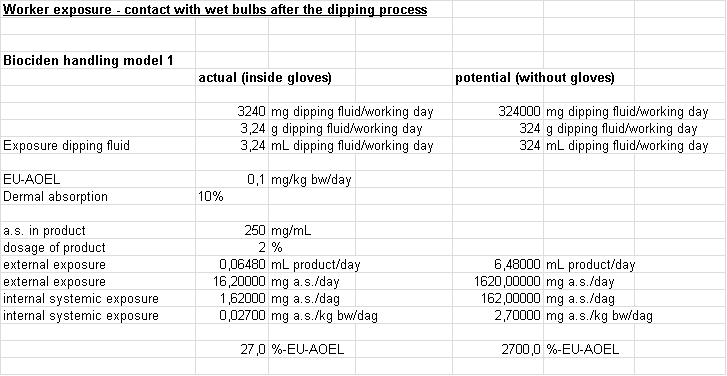Werkinstructie rekenmodel blootstelling werker bij boldompeling
Voor de risicobeoordeling van werken met natte behandelde bloembollen in de trekteelt was tot voor kort geen representatief model beschikbaar. Het sinds 1 januari 2016 verplicht gestelde EFSA OPEX model voorziet niet in deze blootstellingsroute. Op verzoek van het Ctgb heeft het RIVM een representatief blootstellingsmodel voorgesteld uit de biociden EU guidance.
Het college heeft besloten dat voor dossiers ingediend op of vanaf 1 oktober 2016 dit blootstellingsmodel door de aanvrager gebruikt dient te worden bij de risicobeoordeling van de werker voor middelen die toegepast worden voor boldompeling in de trekteelt.
Een nadere omschrijving van het blootstellingsmodel en een voorbeeldberekening staat hieronder.
Worker risk assessment of products used for bulb dipping
IIIA 7.5.1 Estimation of worker exposure without personal protective equipment
After dipping of the bulbs for the forcing cultivation, exposure of the worker due to contact with treated bulbs cannot be excluded as these will be manually planted in crates. For the exposure assessment of workers handling wet flower bulbs after dipping, there is no suitable model available. The available re-entry model (EFSA OPEX) is based on the use of a crop specific transfer coefficient to calculate the dermal load of a daily task. These models assume that residues are transferred continuously from crops to the workers skin, starting at zero to a maximum load at the end of the shift, thus a continuously constant increase of the dermal load. These models are developed to estimate the transfer of dry residues. Exposure from handling of wet bulbs after dipping is in fact a different process and requires a different approach. The worker has contact with a concentration of the active substance equal to the concentration of the bulb treatment solution. The first contact with wet bulbs surface immediately leads to a maximal dermal load which is maintained throughout the shift as a liquid layer of bulb dip solution is continuously transferred from the wet bulbs to the hands.
In the Technical Notes for Guidance for the exposure assessment of biocidal products (TNSG 2002) several models are available for estimating the exposure when handling wet surfaces. The TNsG ‘Handling contact with wet surfaces model 1’ seems most appropriate to estimate the worker exposure resulting from planting tasks after bulb dipping. This model describes hand contact with wet or moist wood over an average period of 3 hours (cycle). As a realistic worst-case exposure value the 75th percentile hands default inside gloves (1080 mg/cycle; n=43 data points) may be used and three cycles per day may be assumed, i.e. 3240 mg/day.
In addition, according to the HEEG opinion on the assessment of Potential & Actual Hand Exposure (agreed at TMI08, 2008), the exposure without gloves may be estimated by using a multiplication factor of 100 for the conversion of actual to potential hand exposure (thus 3240 mg/day x 100 = 324000 mg dipping fluid/day). These exposure values equals to 324 mL dipping fluid/day without gloves and 3.24 mL dipping fluid/day with the use of gloves.
For the risk assessment, these exposure estimates are recalculated to mg a.s./day based on the concentration active substance used in the dipping fluid. Then the predicted systemic exposure is calculated by correcting for dermal absorption and compared with the AOEL.
The exposure is estimated for the unprotected worker. In Table 7.5.1-1 the estimated exposure is compared with the systemic EU-AOEL. The model calculation is presented in Appendix 1.
Table 7.5.1-1 Estimated worker exposure to active substance XXX (without PPE)
|
Estimated internal exposurea |
Systemic |
% EU-AOEL b |
|
|
Worker activities in wet flower bulbs (concentration formulation in dipping fluid 2%) |
|||
|
Total |
2.7 |
0.1 |
2700 |
a. External exposure was estimated with TNsG Handling contact with wet surfaces model 1. Internal exposure was calculated with a biological availability via the dermal route of 10% and a bodyweight of 60 kg.
b. The % AOEL is calculated by dividing the internal exposure by the systemic AOEL and multiplying this by 100%.
Based on the estimated worker exposure, it is concluded that there is an unacceptable risk anticipated for the worker without the use of PPE from handling of wet bulbs after dipping with product XXXX. Therefore further estimations of the exposure for workers are required taking in to consideration the use of personal protective products (PPP).
IIIA 7.5.2 Estimation of worker exposure using personal protective equipment
The estimated worker exposure for handling of wet bulbs after dipping without PPE exceeded the EU-AOEL. The exposure of the worker using personal protective equipment (gloves) is given in Table 7.5.1.-2.
Table 7.5.1-2 Estimated worker exposure to active substance XXX (with and without PPE)
|
Estimated internal exposure a (mg/kg bw/day) |
Systemic AOEL |
% AOEL b |
|||
|
without PPE |
with PPE |
without PPE |
with PPE (gloves) |
||
|
Worker activities in wet flower bulbs (concentration formulation in dipping fluid 2%) |
|||||
|
Total |
2.7 |
0.027 |
0.1 |
2700 |
27 |
a. External exposure was estimated with TNsG Handling contact with wet surfaces model 1. Internal exposure was calculated with a biological availability via the dermal route of 10% and a bodyweight of 60 kg.
b. The % AOEL is calculated by dividing the internal exposure by the systemic AOEL and multiplying this by 100%.
Based on the estimated worker exposure, it is concluded that there is no unacceptable risk anticipated for the worker with the correct use of PPE (gloves) from handling of wet bulbs after dipping with product XXXX.
Appendix 1.
